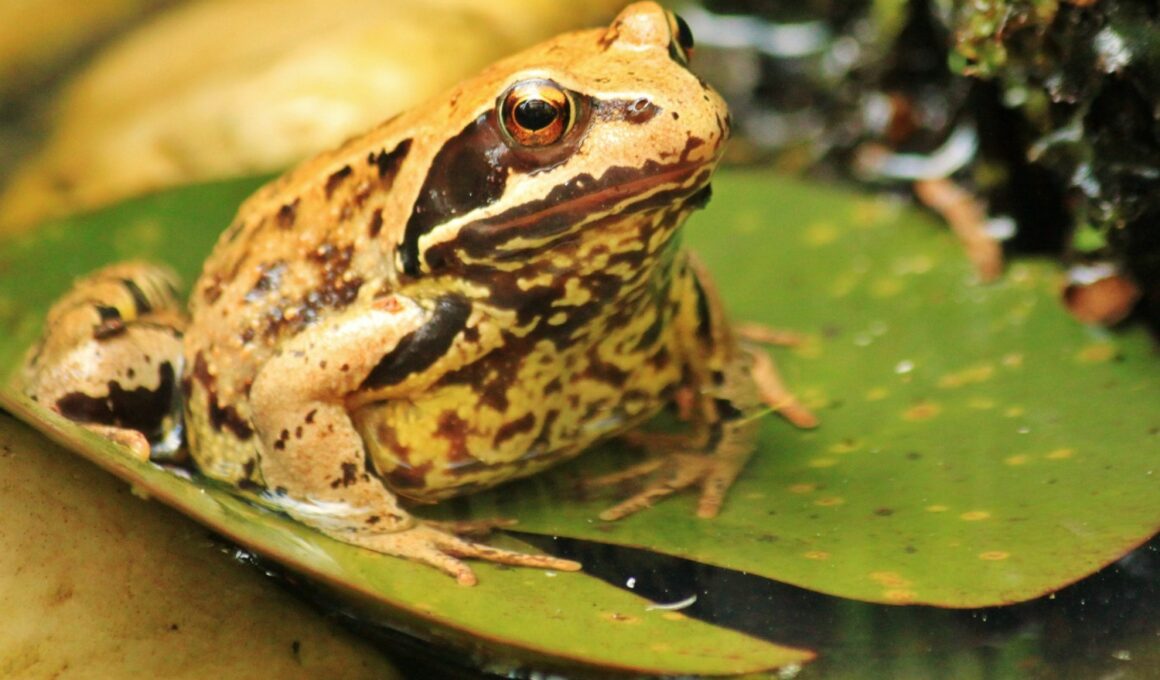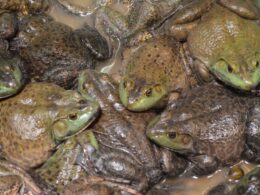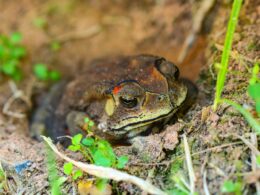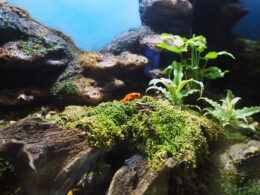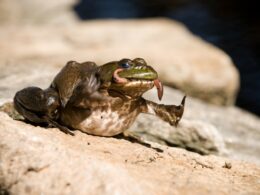In this article Show
As someone who’s spent countless hours diving into the intricate world of reptiles and amphibians, I’ve come across many fascinating creatures. However, one that consistently stands out is the Pacman frog.
This plump, colorful, and often vocal amphibian has captivated the hearts of many pet owners around the world, and for good reason.
Why “Pacman”, you ask? Its wide mouth and rounded body reminiscent of the popular video game character is a dead giveaway. But there’s more to this intriguing creature than just its playful appearance.
Native to the rainforests of South America, the Pacman frog offers a unique blend of aesthetics, behavior, and care requirements that make it both a challenge and a delight to keep as a pet.
Whether you’re considering adopting one or are merely curious about this chunky little frog, our comprehensive guide on the Pacman frog is here to help.
Physical Characteristics of the Pacman Frog
The Pacman frog, also scientifically known as Ceratophrys, is not your typical dainty amphibian. When you first lay eyes on one, you’ll likely be struck by its robust and round appearance. Let’s delve deeper into its physical attributes:
1. Description of Its Appearance
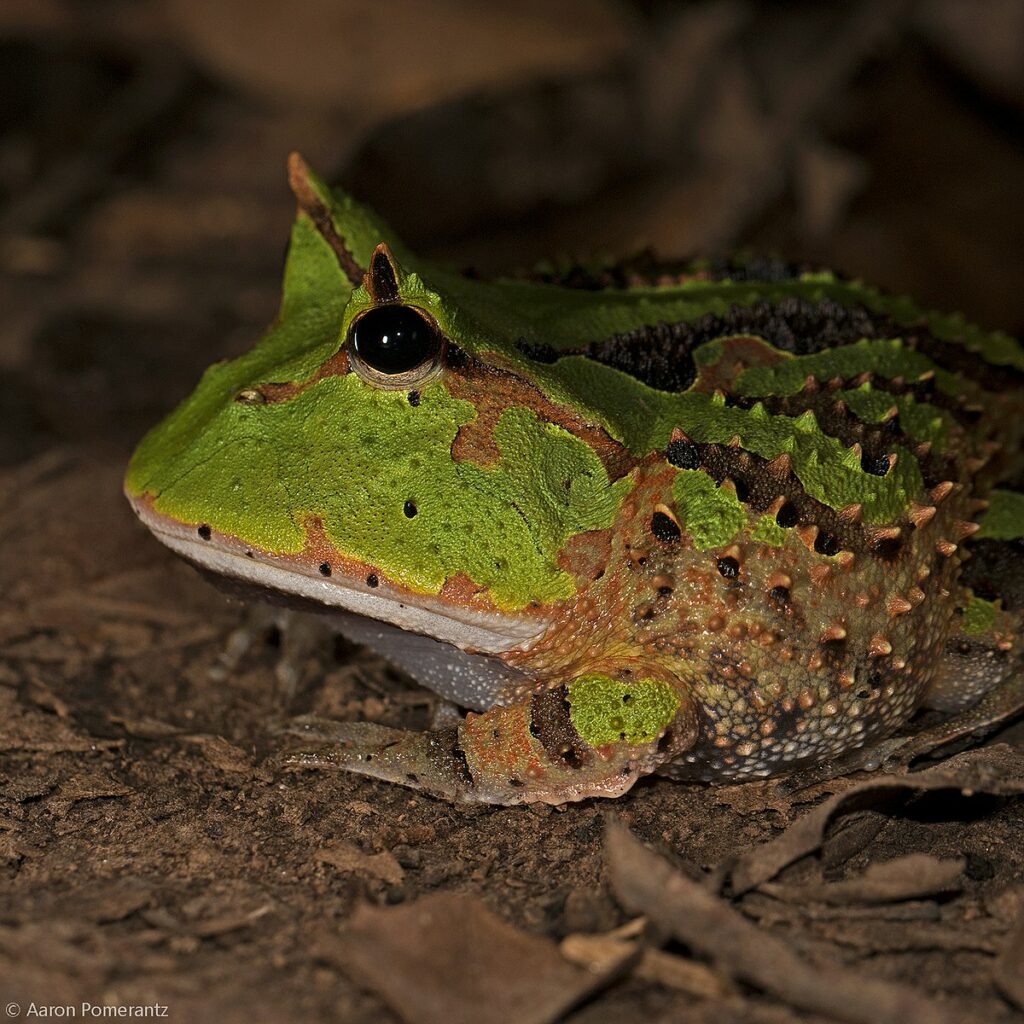
At first glance, the Pacman frog looks like a chunky, almost overweight frog with a large mouth that spans almost the entire width of its head. This wide mouth is where it gets its moniker from, bearing an uncanny resemblance to the 80s video game icon, Pac-Man.
Its eyes are positioned on top of its head, giving it an upward gaze, which aids in spotting potential prey from its burrowing position.
2. Range of Colors And Patterns
Pacman frogs boast a vibrant spectrum of colors and patterns. While the most common shades you might encounter are green and brown, there are also ornate Pacman frogs that exhibit a mix of bright yellows, reds, and even blues. Some may have spots, others might showcase stripes, and a few could even flaunt intricate mottled patterns.
These colors and patterns not only make them visually appealing but also serve as camouflage in their natural habitats, helping them blend seamlessly with their surroundings.
3. Typical Size and Lifespan
Size-wise, the Pacman frog is relatively modest. Males typically reach sizes of about 2.5 to 4 inches, while females, being the larger sex, can grow to a substantial 4 to 7 inches in diameter. With proper care and optimal living conditions, a Pacman frog can lead a hearty life of 6 to 10 years in captivity.
This longevity makes them a long-term commitment, but one that many amphibian enthusiasts find incredibly rewarding.
In Essence 🐸
The Pacman frog’s physical characteristics are a blend of functional adaptations and sheer aesthetic appeal. Whether you’re drawn to their quirky appearance or their striking color variations, there’s no denying that these frogs are a visual treat.
Natural Habitat and Distribution
The world has diverse habitats, each teeming with life and unique ecosystems. Among these, the Pacman frog has carved out its niche in a particular region that is as vibrant and fascinating as the frog itself.
Regions Where Pacman Frog is Found in the wild
The Pacman frog is native to South America, primarily spanning countries like Argentina, Brazil, and Paraguay. Within these regions, they predominantly inhabit tropical and subtropical rainforests.
However, they’re not always found leaping from tree to tree or swimming in freshwater streams; instead, they have a preference for the forest floor. Here, the leaf litter, moist soil, and occasional water puddles provide the perfect backdrop for their existence.
Environmental Conditions They Thrive In
The floor of the rainforest provides a moist, humid, and warm environment, essential for the Pacman frog’s well-being. The humidity levels in their natural habitat often hover around 80% or higher.
Temperatures, on the other hand, are consistently warm, usually ranging from 75 to 85°F (24 to 29°C) during the day, with slight drops during nighttime.
The thick canopy of the rainforest offers protection from direct sunlight, meaning that while they’re accustomed to light, they aren’t frequently exposed to intense brightness.
This dappled, filtered light is something they’ve adapted to over time. Additionally, the loose, soft soil of the forest floor allows them to burrow and hide – an essential behavior, especially when they feel threatened or during times of rest.
Understanding the Pacman frog’s natural habitat provides valuable insights into their care requirements in captivity. By mimicking these conditions as closely as possible, one can ensure a healthy, happy, and thriving pet.
Diet and Feeding
A creature’s diet often reflects the ecosystem it hails from. For the Pacman frog, a voracious eater by nature, its dietary habits offer a fascinating glimpse into its predatory instincts and the rich biodiversity of its natural habitat.
What They Eat in The Wild
In the dense rainforests of South America, Pacman frogs are ambush predators. Using their impeccable camouflage and a great deal of patience, they wait for unsuspecting prey to come within reach.
Their diet in the wild is diverse and consists primarily of insects like crickets, beetles, and spiders. However, their large mouths and voracious appetites mean they can tackle larger prey too.
It’s not uncommon for these frogs to consume other amphibians, small reptiles, and even birds or small mammals if the opportunity presents itself.
Recommended Diet For Pet Pacman Frogs
When kept as pets, it’s essential to provide a balanced and varied diet to ensure their health and longevity. Commonly, pet Pacman frogs thrive on a diet of:
- Crickets: These are staple feeders, rich in protein. Ensure they are appropriately sized for your frog.
- Worms: Earthworms or nightcrawlers are a favorite. They’re both nutritious and enticing for the frogs.
- Roaches: Dubia roaches or similar varieties can be an excellent addition to diversify their diet.
- Mealworms and Superworms: These can be given occasionally, but they’re higher in fat.
- Pinkie mice: For adult Pacman frogs, these can be offered occasionally as a protein boost but should be given sparingly due to their high fat content.
It’s also recommended to dust the prey with calcium and vitamin supplements to ensure the frog receives all essential nutrients, especially when they’re not getting the diverse diet they would in the wild.
Frequency And Quantity of Feeding
Pacman frogs, while enthusiastic eaters, can become overweight if overfed. Thus, monitoring their intake is crucial.
Juveniles
They’re growing and thus require more frequent feeding. You can feed them daily or every other day, offering as much as they will consume in a short feeding session.
Adults
As they grow, their metabolism slows down. Feeding them 2-3 times a week is usually sufficient. Keep an eye on their body condition and adjust accordingly. Remember, it’s easier for them to gain weight than to lose it.
In Essence 🐸
Feeding a Pacman frog can be an exciting and rewarding experience. Witnessing their ambush tactics and rapid feeding response can be a spectacle in itself. By understanding their dietary needs and preferences, you’ll be well on your way to ensuring your amphibian friend leads a healthy and contented life.
Housing and Habitat Setup for Pet Pacman Frogs
Setting up the perfect home for a Pacman frog isn’t just about aesthetics or convenience; it’s a direct emulation of the conditions they’ve evolved in for millions of years. To ensure your Pacman frog feels right at home and thrives in captivity, here’s a guide to creating the ideal environment.
Suitable Size And Type of Terrarium
- Size: While Pacman frogs aren’t the most active amphibians, they still require space. For a juvenile, a 10-gallon terrarium can suffice. However, as they grow, especially the larger females, upgrading to a 20-gallon tank is advisable.
- Type: A standard glass terrarium works well, as it retains humidity efficiently. Ensure it has a securely fitting lid, both to maintain humidity and to prevent any potential escapes.
Substrate Recommendations
The substrate is pivotal for Pacman frogs, as they’re natural burrowers.
- Coconut Coir: This is a top choice for many. It retains moisture well and is naturally resistant to mold and fungi.
- Sphagnum Moss: This can be used in conjunction with coconut coir, especially in areas where you want to retain extra moisture.
- Avoid Sand, gravel, and wood chips. These can be ingested accidentally and lead to impaction.
Ensure the substrate remains moist but not waterlogged. A depth of 2-3 inches is ideal, allowing them to burrow comfortably.
Temperature, Humidity, and Lighting Requirements
Temperature
Recall their tropical origins; Pacman frogs prefer temperatures between 75 to 85°F (24 to 29°C). During nighttime, a slight drop is natural, but it shouldn’t fall below 65°F (18°C). A heat mat under one side of the terrarium can help maintain this gradient, but always use a thermostat to avoid overheating.
Humidity
High humidity levels, around 70-80%, are crucial. This can be maintained by misting the terrarium regularly with dechlorinated water and using a hygrometer to monitor levels.
Lighting
While they don’t require UVB lighting as some reptiles do, a regular day-night cycle is crucial for their well-being. Natural room lighting is usually sufficient. If additional lighting is used, ensure it’s not too harsh and follows a 12-hour light/dark cycle.
In Essence 🐸
While the Pacman frog’s housing requirements might seem meticulous, they’re a direct reflection of the intricate and lush rainforest environment they hail from. By recreating this habitat as closely as possible, you’re not just providing them a home; you’re gifting them a piece of the wild right in your living room.
Behavior And Temperament of The Pacman Frog
Each creature on our planet, big or small, exhibits behaviors that narrate tales of their evolution, survival tactics, and interactions with the world around them. The Pacman frog is no exception. Delving into its behavior and temperament can help enthusiasts better understand and appreciate these fascinating amphibians.
Pacman Frog’s General Behavior in The Wild And in Captivity
Ambush Predator
Both in the wild and captivity, Pacman frogs are primarily ambush predators. They tend to burrow themselves into the substrate, leaving only their eyes exposed, waiting patiently for prey to wander close enough to strike.
Lethargy
They are not the most active frogs. Don’t be alarmed if your Pacman frog seems to stay in one spot for extended periods – this is typical behavior. Their sedentary lifestyle aids in conserving energy for those quick, explosive moments when they capture prey.
Their Vocalizations And What They Mean
Mating Calls
Males are known for their loud calls, especially during the breeding season. These calls are meant to attract females and establish territory.
Distress Sounds
When threatened or handled, Pacman frogs might emit a loud croak or scream. This startling sound can deter predators, giving the frog a chance to escape.
Chirping
Occasionally, you might hear soft chirping, which is still being researched but is believed to be a form of communication or a sign of contentment.
How They Interact With Other Frogs And Animals
Solitary by Nature
Pacman frogs are solitary animals and can be highly territorial. It’s not recommended to house them together, as they might become aggressive towards each other, leading to injuries or even cannibalism.
Predatory Instincts
Their large mouths and opportunistic feeding habits mean they can view smaller animals, including other frogs, as potential prey. Even in a captive setting, it’s best not to house them with other animals.
Handling Caution
While some pet owners might handle their Pacman frogs occasionally, it’s essential to remember they can deliver a surprisingly strong bite if they feel threatened. Always approach with caution, and limit handling to when it’s necessary, such as habitat cleaning.
In Essence 🐸
The Pacman frog, with its distinctive behaviors and bold temperament, offers a captivating glimpse into the world of amphibians. Their unique characteristics, from ambush hunting to their vocal expressions, make them a subject of intrigue for both seasoned herpetologists and curious onlookers alike.
Breeding And Reproduction of Pacman Frogs
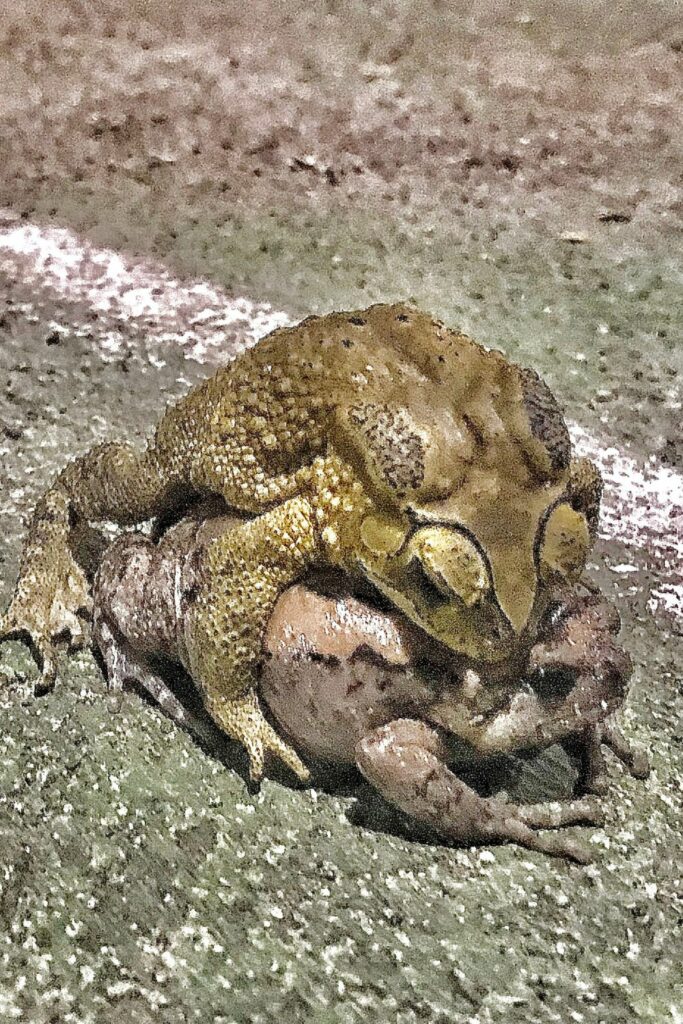
The journey from a single egg to a fully grown Pacman frog is a captivating sequence of stages, each highlighting nature’s finesse and the species’ evolutionary adaptability.
If you’re considering breeding these fascinating amphibians or are simply intrigued by their reproductive habits, here’s a comprehensive look into their breeding and reproduction.
1. Mating Behaviors
Calling
As the breeding season approaches, males intensify their calls to attract females. These calls, as mentioned, are loud and distinct, serving both as an allure for females and a deterrent for rival males.
Amplexus
Once a female is receptive, the male will grasp her in a type of embrace called amplexus. This ensures that when the female releases her eggs, the male can simultaneously release sperm to fertilize them. This embrace can last several hours.
2. Egg-laying and Tadpole Stages
Egg Deposition
After successful amplexus, the female lays her eggs, often in shallow water or damp areas. A single female can lay anywhere from 1,000 to 2,000 eggs, depending on her size and age.
Tadpole Emergence
Within a week or so, the fertilized eggs hatch into tadpoles. Initially, these tadpoles will feed on the remaining yolk sac from their egg. As they grow, they start feeding on algae, detritus, and even small aquatic organisms.
Metamorphosis
Over the next several weeks, these tadpoles undergo a dramatic transformation. They start growing legs, their tails recede, and their diet shifts from herbivorous to carnivorous. This process culminates in the emergence of young, fully-formed Pacman frogs ready to start their terrestrial lives.
3. Rearing Baby Pacman Frogs
Habitat
Initially, since they’re aquatic, tadpoles should be kept in shallow water with a gentle filter to keep the water clean. As they undergo metamorphosis, introduce a land area using sloping substrate or rocks.
Diet
Baby Pacman frogs, once fully terrestrial, can be fed pinhead crickets, small worms, or other appropriately-sized prey. Ensure these are dusted with calcium and vitamin supplements to support healthy growth.
Separation
Given their predatory nature, it’s advisable to separate young Pacman frogs as they grow to prevent cannibalistic tendencies. Keeping them in individual containers or well-divided terrariums ensures each frog gets adequate food and avoids potential conflicts.
Breeding Pacman frogs is both a challenge and a reward. Observing the full circle of life, from mating calls to the emergence of young frogs, offers a firsthand experience of nature’s wonders and the intricate processes that sustain life on our planet.
Health and Common Illnesses of Pacman Frogs
Maintaining the health and well-being of your Pacman frog is paramount. Recognizing signs of a healthy frog, understanding potential ailments, and knowing when to seek professional help can ensure your amphibious friend leads a long and fulfilling life.
Signs of a Healthy Pacman Frog
- Active Eyes: Their eyes should be clear, bright, and free of cloudiness or discharge. They should respond to stimuli and not appear sunken.
- Healthy Skin: Their skin should be smooth and moist without any lesions, discolorations, or unusual bumps.
- Steady Weight: While Pacman frogs are naturally chunky, they shouldn’t appear emaciated or overly bloated. A steady, consistent weight is a good sign.
- Appetite: A healthy Pacman frog will exhibit a good appetite, showing interest in food and eating regularly.
- Normal Behavior: Though they’re typically sedentary, they should react to their environment, burrow as usual, and not display prolonged unusual behaviors.
Common Diseases and How to Prevent/Treat Them
Red Leg Syndrome
This is a bacterial infection that can cause reddening of the legs and belly. It’s often fatal if not treated promptly. Maintaining clean water and a sanitary environment can help prevent it. If suspected, seek veterinary help immediately.
Impaction
This occurs when a foreign object, like substrate, is ingested and causes a blockage. To prevent this, use appropriate substrates like coconut coir and ensure prey size is suitable. Impaction might require surgical intervention.
Fungal Infections
Symptoms include skin discolorations or unusual sliminess. Keeping the terrarium clean and ensuring good water quality can prevent fungal outbreaks. Antifungal treatments, as prescribed by a veterinarian, can treat these infections.
Metabolic Bone Disease (MBD)
This results from calcium or vitamin D3 deficiencies. Symptoms include weak limbs or a misshapen jaw. Ensuring a proper diet with supplemented prey can prevent MBD. If suspected, consult a vet for dietary adjustments and potential treatments.
When to Consult a Veterinarian
- Visible Ailments: If you notice any lumps, discolorations, lesions, or other visible abnormalities.
- Behavioral Changes: If your frog stops eating, becomes overly lethargic, or exhibits unusual behaviors for extended periods.
- Post-Injury: If your frog has sustained an injury or has been in a potentially harmful situation.
- Routine Check-ups: Just as with other pets, periodic visits to a vet specializing in amphibians can catch potential issues early and ensure your frog’s overall health.
In Essence 🐸
While Pacman frogs are hardy creatures, they aren’t exempt from health challenges. Being observant, maintaining a clean habitat, and feeding a balanced diet can go a long way in ensuring they remain healthy and vibrant.
Pros and Cons of Keeping a Pacman Frog as a Pet
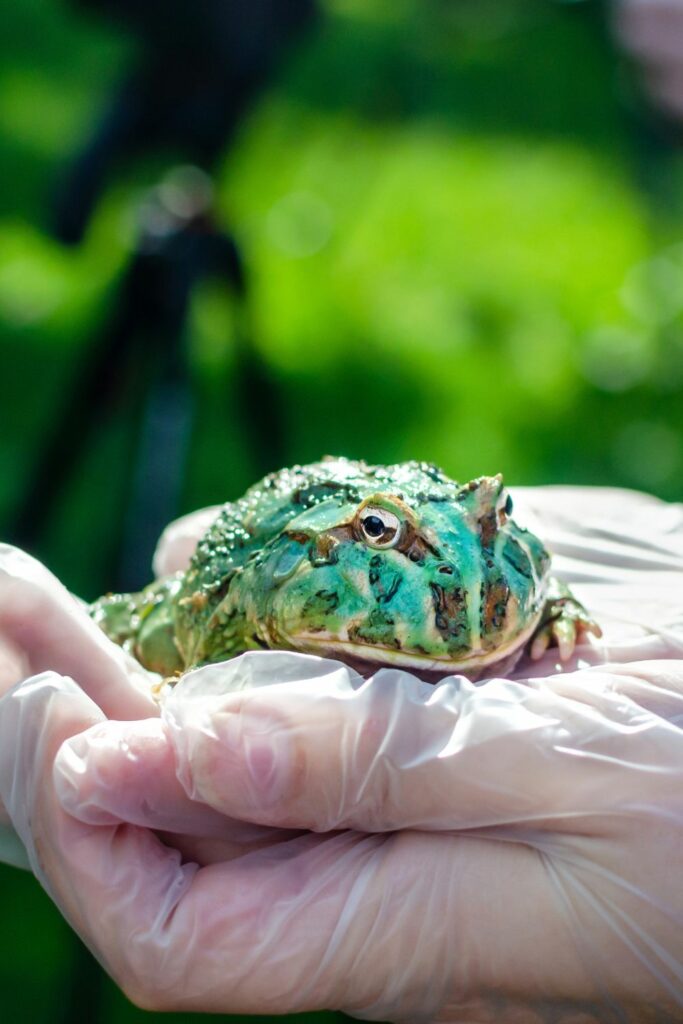
Like all pets, keeping a Pacman frog comes with its joys and challenges. Understanding both can help potential frog owners make informed decisions and set realistic expectations. Here’s a balanced look at the pros and cons of having a Pacman frog as a companion:
Benefits of Having a Pacman Frog
Low Space Requirement
Pacman frogs are relatively sedentary and don’t need vast spaces. A reasonably sized terrarium can comfortably house them, making them suitable for small living spaces.
Unique Appearance
With their round bodies, wide mouths, and vibrant colors, they are undeniably intriguing to look at.
Easy Feeding
Unlike some pets that require daily feeding, adult Pacman frogs can be fed 2-3 times a week, simplifying their care routine.
Educational Value
They can be a fantastic educational tool for children, teaching them about amphibian life cycles, ecosystems, and responsible pet care.
Minimal Noise
Apart from the occasional mating call from males, they’re quiet pets, unlike dogs or birds that might create regular noise
Challenges and Considerations
- Limited Interaction: Pacman frogs aren’t the kind of pets you can play with or handle regularly. They’re more for observation and appreciation.
- Specialized Habitat Needs: Maintaining the right temperature, humidity, and lighting can require some effort and equipment.
- Potential Health Issues: As with all pets, they can develop health problems. Regular check-ups and a keen observation are vital.
- Dietary Needs: Their diet might not be for the squeamish. Feeding them live or frozen prey, like crickets or mice, is a part of their care.
- Long-Term Commitment: With a lifespan of up to 10 years, they are a long-term commitment, requiring consistent care throughout their lives.
In conclusion, while Pacman frogs offer a unique and rewarding pet-keeping experience, they also come with their set of challenges. As with any pet decision, it’s essential to weigh the pros and cons and ensure you’re prepared for the responsibilities that come with caring for these captivating amphibians.





